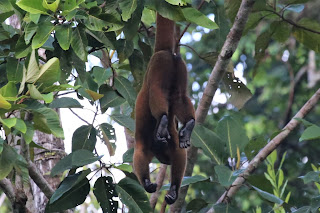Friday, March 13, 2020. I managed to get up early enough for the morning boat ride. For one thing, I feel so much perkier since I’ve stopped taking the malaria medicine! For another, they had promised us different, bigger monkeys. They did not disappoint!
Early in the ride, we saw this spider monkey posing for us. (top picture)
Then an entire family of woolly monkeys, with babies, played in the tree in front of us. One of them was nice enough to come to the front of the tree to eat some berries, giving us a great opportunity for pictures.
We then found a family of Monk Saki monkeys, and again managed to see a couple of them close enough to see their faces and their enormous tails.
Along the way, we saw many birds, including this nesting parakeet, also using a woodpecker’s hole, And these nesting yellow-rumped caciques flying in and out of their nest. (see end of blog)
We also passed a couple of the tree house lodges- another way to visit the Amazon - which looked very similar to where Emily and Claire stayed when they came here a few years ago.
After breakfast, we went to one of the many small villages that dot the shore of the river. The river and it’s many tributaries constitute the only road system here. Ferry’s go up and down from Iquitos. For some, it’s a week’s trip each way (bring your own hammock to sleep on the middle deck). Yet, people do travel - some to sell their harvest, and then buy supplies - most importantly salt, which cannot be found here.
We met the school children - this particular village has a K-6 school, after which children go (by boat) either to one of the largest villages, or to Nauta or Iquitos (in which case, they live with relatives). The children were cute and silly: they introduced themselves, sang songs, and giggled a lot. They were very sweet. They do all look very healthy, although the guide said that 80% of them suffer from anemia, which is why the government supplies iron supplement crackers for them.
We walked through the small village, whose houses are almost all build on stilts, because when the river is high, it can come up to 3 feet through the the Main Street. Since chickens live under the houses, they have to sell the chicken when that happens, because they can no longer feed them.
This village is struggling with erosion right now - the school, which used to be 100 yard from the shore is now close enough to it that it will have to be moved very shortly.
They keep a butterfly breeding dome - which was started by the government, but is now primarily funded by environmentalists and tourists. We got to name and release newly hatched butterflies (I named mine Mary, for my soon to be hatched grand-daughter).
The children keep this little monkey as a pet- this one is very young, and the guide suggested that they stole it from the mother (which is illegal as it’s a protected species). This particular monkey is supposed to bring good luck, which is probably why they took it. While upsetting, it did look well cared for. We then had a cooking demonstration (fish wrapped in acacia leaves) before heading back to the ship for lunch.
After a lecture on the important role of baboons in Egyptian arts and how to use that to understand the voyages of the early Egyptians (a truly fascinating topic that I have neither the time, nor enough knowledge to discuss here), we reviewed our itinerary (We explored the Pacaya Samiria reserve between the Maranon - starting at Nauta- and the Ucayali River, as well as some of the villages in the “buffer zone (not part of the reserve, but on the other bank of the river, so still having a special status) and then followed the Amazon river to Iquitos, from which we are flying out tomorrow. We also reviewed the list of the many birds and other animal we have seen, which give me some hope that we will be able to identify all the pictures Joe took once we are back.
We were supposed to go on one last boat ride on the Amazon River, which we are now on, going toward Iquitos. But a thunderstorm came through just as we were about to embark, so instead, we had a last toast inside while our excellent crew band regaled us one more time with a mixture of Peruvian music and Elvis songs (really- it was excellent!- the guys on the flute and the 12 string mandolin were exceptional!).
One of the crew members even got Joe to dance!
The cruise director gave a very moving speech about the importance of the rain forest and of the culture of the people who live here. Most of the crew members grew up in these small villages along the river, without electricity, roads, tv, etc. They have very strong roots here and love it. Yet, they feel they are very lucky for the education they were able to get, and for getting good jobs in a place of limited opportunities. But they want to preserve the Amazon and the rainforest, and hope that by showing it to us, they can help us understand how special it is. They are really beautiful and kind people, and I hope we can indeed help.













No comments:
Post a Comment